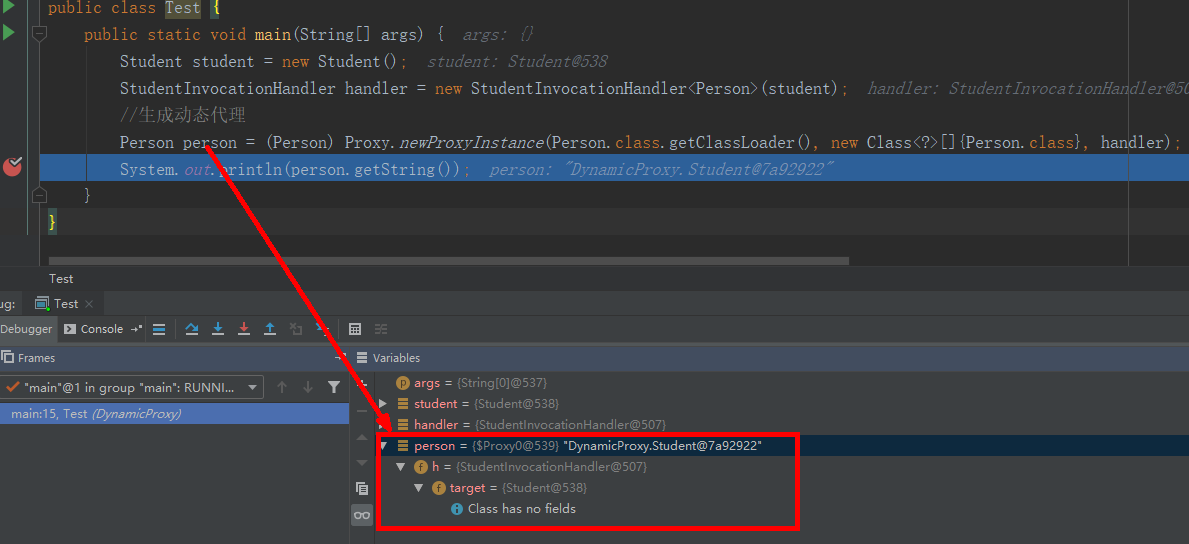接口:
public interface Person { String getString(); }
实现类:
public class Student implements Person{ public String getString(){ return "sss"; } }
InvocationHandler实现类:
public class StudentInvocationHandler<T> implements InvocationHandler { T target; public StudentInvocationHandler(T target) { this.target = target; } @Override public Object invoke(Object proxy, Method method, Object[] args) throws Throwable { return method.invoke(target,args); } }
测试类:
public class Test { public static void main(String[] args) { Student student=new Student(); StudentInvocationHandler handler = new StudentInvocationHandler<Person>(student); //生成动态代理 Person person =(Person) Proxy.newProxyInstance(Person.class.getClassLoader(), new Class<?>[]{Person.class}, handler); System.out.println(person.getString()); } }
生成的代理类在debug模式下如下,可以看到person值为代理类$Proxy0,是Student的代理类,此类的特点是和Student一样都实现了Person接口。

可以通过以下方式获取$Proxy0的源码:
public static void main(String[] args)throws Exception{ byte[] proxyClass=ProxyGenerator.generateProxyClass("$Proxy0",Student.class.getInterfaces()); //将代理类person的源码输出到文件,然后用IDEA等工具打开查看 File file=new File("E:/$Proxy0.class"); FileOutputStream fileOutputStream=new FileOutputStream(file); fileOutputStream.write(proxyClass); fileOutputStream.close(); }
代理类的结构如下:

$Proxy0的源码如下,可见代理类实现了Person接口并且继承了Proxy类,当执行代理类的getString方法时,就会执行StudentInvocationHandler的invoke方法
// // Source code recreated from a .class file by IntelliJ IDEA // (powered by Fernflower decompiler) // import DynamicProxy.Person; import java.lang.reflect.InvocationHandler; import java.lang.reflect.Method; import java.lang.reflect.Proxy; import java.lang.reflect.UndeclaredThrowableException; public final class $Proxy0 extends Proxy implements Person { private static Method m1; private static Method m2; private static Method m0; private static Method m3; public $Proxy0(InvocationHandler var1) throws { super(var1); } public final boolean equals(Object var1) throws { try { return (Boolean)super.h.invoke(this, m1, new Object[]{var1}); } catch (RuntimeException | Error var3) { throw var3; } catch (Throwable var4) { throw new UndeclaredThrowableException(var4); } } public final String toString() throws { try { return (String)super.h.invoke(this, m2, (Object[])null); } catch (RuntimeException | Error var2) { throw var2; } catch (Throwable var3) { throw new UndeclaredThrowableException(var3); } } public final int hashCode() throws { try { return (Integer)super.h.invoke(this, m0, (Object[])null); } catch (RuntimeException | Error var2) { throw var2; } catch (Throwable var3) { throw new UndeclaredThrowableException(var3); } } public final String getString() throws { try { return (String)super.h.invoke(this, m3, (Object[])null);//会调用父类(Proxy类)的h(StudentInvocationHandler)的invoike方法 } catch (RuntimeException | Error var2) { throw var2; } catch (Throwable var3) { throw new UndeclaredThrowableException(var3); } } static { try { m1 = Class.forName("java.lang.Object").getMethod("equals", Class.forName("java.lang.Object")); m2 = Class.forName("java.lang.Object").getMethod("toString"); m0 = Class.forName("java.lang.Object").getMethod("hashCode"); m3 = Class.forName("DynamicProxy.Person").getMethod("getString"); } catch (NoSuchMethodException var2) { throw new NoSuchMethodError(var2.getMessage()); } catch (ClassNotFoundException var3) { throw new NoClassDefFoundError(var3.getMessage()); } } }
源码解析:Proxy.newProxyInstance
此方法为指定接口返回代理类的一个实例
此方法为指定接口返回代理类的一个实例
public class Proxy implements java.io.Serializable { private static final long serialVersionUID = -2222568056686623797L; /** parameter types of a proxy class constructor */ private static final Class<?>[] constructorParams = { InvocationHandler.class }; /** * the invocation handler for this proxy instance. * @serial */ protected InvocationHandler h; /** * Returns an instance of a proxy class for the specified interfaces * that dispatches method invocations to the specified invocation * handler. * * <p>{@code Proxy.newProxyInstance} throws * {@code IllegalArgumentException} for the same reasons that * {@code Proxy.getProxyClass} does. * * @param loader the class loader to define the proxy class * @param interfaces the list of interfaces for the proxy class * to implement * @param h the invocation handler to dispatch method invocations to * @return a proxy instance with the specified invocation handler of a * proxy class that is defined by the specified class loader * and that implements the specified interfaces * @throws IllegalArgumentException if any of the restrictions on the * parameters that may be passed to {@code getProxyClass} * are violated * @throws SecurityException if a security manager, <em>s</em>, is present * and any of the following conditions is met: * <ul> * <li> the given {@code loader} is {@code null} and * the caller's class loader is not {@code null} and the * invocation of {@link SecurityManager#checkPermission * s.checkPermission} with * {@code RuntimePermission("getClassLoader")} permission * denies access;</li> * <li> for each proxy interface, {@code intf}, * the caller's class loader is not the same as or an * ancestor of the class loader for {@code intf} and * invocation of {@link SecurityManager#checkPackageAccess * s.checkPackageAccess()} denies access to {@code intf};</li> * <li> any of the given proxy interfaces is non-public and the * caller class is not in the same {@linkplain Package runtime package} * as the non-public interface and the invocation of * {@link SecurityManager#checkPermission s.checkPermission} with * {@code ReflectPermission("newProxyInPackage.{package name}")} * permission denies access.</li> * </ul> * @throws NullPointerException if the {@code interfaces} array * argument or any of its elements are {@code null}, or * if the invocation handler, {@code h}, is * {@code null} */ @CallerSensitive public static Object newProxyInstance(ClassLoader loader, Class<?>[] interfaces, InvocationHandler h) throws IllegalArgumentException { Objects.requireNonNull(h); final Class<?>[] intfs = interfaces.clone(); final SecurityManager sm = System.getSecurityManager(); if (sm != null) { checkProxyAccess(Reflection.getCallerClass(), loader, intfs); } /* * Look up or generate the designated proxy class.(查找或者生产代理类的class) */ Class<?> cl = getProxyClass0(loader, intfs); /* * Invoke its constructor with the designated invocation handler. */ try { if (sm != null) { checkNewProxyPermission(Reflection.getCallerClass(), cl); } //根据构造器参数类型获取Constructor<?>类,此测试中constructorParams的值为InvocationHandler.class final Constructor<?> cons = cl.getConstructor(constructorParams); final InvocationHandler ih = h; if (!Modifier.isPublic(cl.getModifiers())) { AccessController.doPrivileged(new PrivilegedAction<Void>() { public Void run() { cons.setAccessible(true); return null; } }); } //根据构造器和构造器参数生成代理类实例,此测试中h的值为 return cons.newInstance(new Object[]{h}); } catch (IllegalAccessException|InstantiationException e) { throw new InternalError(e.toString(), e); } catch (InvocationTargetException e) { Throwable t = e.getCause(); if (t instanceof RuntimeException) { throw (RuntimeException) t; } else { throw new InternalError(t.toString(), t); } } catch (NoSuchMethodException e) { throw new InternalError(e.toString(), e); } } }